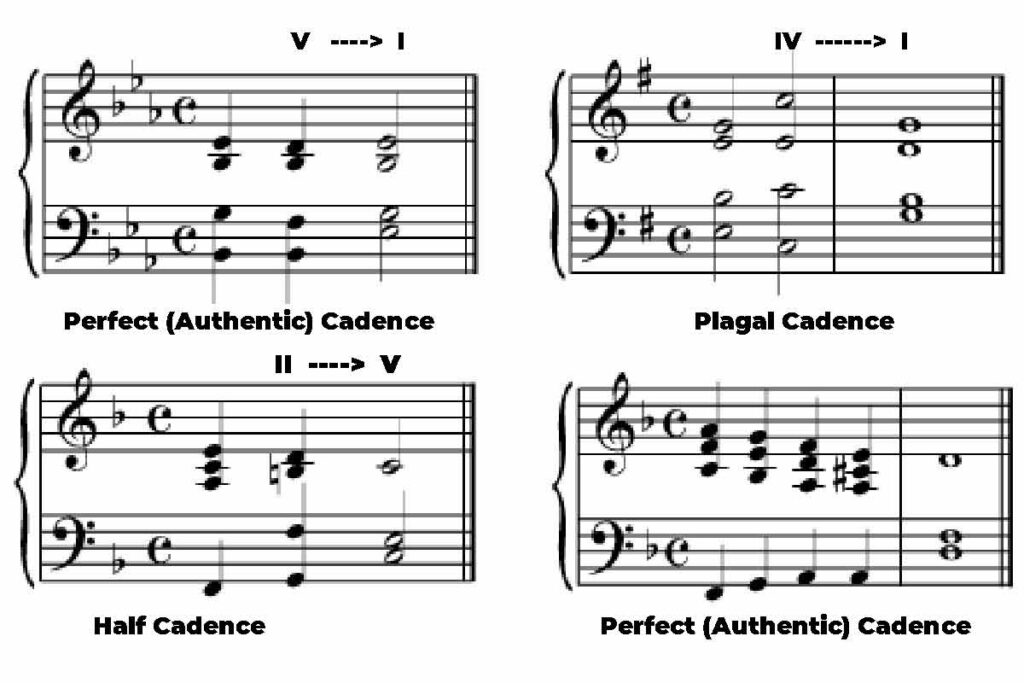A Complete Guide To Half Cadence

Half Cadence or Imperfect Cadence
Half Cadence is one of the four common types of cadences we have in music theory. Basically, a half cadence is all about cadence that ends on a dominant (V) chord irrespective of the chord that precedes it.
Actually, we have discussed the Half Cadence briefly in types of cadences in music. But the focus of this article is majorly on the Half Cadence and we would discuss it thoroughly and carefully here.
In order to achieve that, we will take our time to discuss what Half Cadence is in music theory. In addition to that, we will discuss the chords needed to form a Half Cadence.
Moreover, for a better understanding of half cadences, different examples of Half Cadence will be used to broaden our discussion.
But before we start discussing Half Cadence, we will quickly look into what is cadence in music. This is needed to remind ourselves about the main subject which is cadence before we discuss its part.
What Is Cadence in Music?

Basically, cadence is the progression formed by two chords that end the phrase of a melody or musical piece.
In an actual sense, cadences are used in music to create a sense of ending at the end of a musical phrase. Cadence is always there to underline the end of a phrase This get the performer prepared for the next phrase or section and allow singer to breath.
The effect of cadence in a music context is just like a comma or full stop in speaking or written languages. That is the reason cadences are called music punctuation and are known as resting places in music.
Therefore, in every piece of music, there is always a cadence that defines the end of a phrase, section, or the entire piece.
If we listen very well, we will understand the effect of cadence in a musical context.
Types of Cadences
Although we have different types of cadences in music that we can use to properly bring desired closure to an end of a phrase.
However, four out of them are the most commonly used.
In no particular order, the four common types of cadences we have are listed below.
We can use any of these four types of cadence to create different senses of ending in a piece of music.
Each of the types of cadences has different feelings it created. Accordingly, the composers use the type that is suitable to create the sense of perfect closure needed at the end of the piece.
Also, they use one that creates a sense of something more to come within the piece or the section of the music.
In a nutshell, every type of cadence has its respective function and usage in the musical context.
Absolutely, there is a suitable cadence to raise or create tension within a musical piece. Also, there are cadences that are suitable to close the end of a phrase smoothly to end a section or the entire piece.
For instance, both authentic cadence and plagal cadences give a sense of completion at the end of a phrase. They end a musical phrase completely without imposing any feelings of continuation.
One of the most common ways to create a feeling of continuation at the end of a phrase is using a Half Cadence. In the next section, we will learn more about Half Cadence and how to use it in a musical context.
What Is a Half Cadence?

The Half Cadence is a chord (harmonic) progression at the end of a musical phrase that ends on the dominant. Half cadence as a chord progression that closes on the dominant chord is also known as imperfect cadence.
Typically, this kind of closure can happen in different progressions ranging from any of the scale degrees to the dominant. For example, it can happen with I-V, ii-V, IV-V, and vi-V.
What really matters here is that all the chord progressions end on the dominant. And as a result, we have what we called Half Cadence or Imperfect Cadence.
Absolutely, the effect created by the cadence ending on the dominant will surely not be conclusively satisfying. The reason has been that a phrase or piece can only come to a conclusive ending on the tonic chord.
From the key of C major shown in the diagram above, the Half Cadence will leave the mind unsatisfied. Actually, the cadence will still produce an effect of a stop to some extent but with the expectation of something more to come.
Of course, Half Cadence is unlike Perfect Cadence or Plagal Cadence which is customarily resolved on the tonic and gives a complete sense of closure.
The reason we do not experience a complete sense of final closure with the Imperfect Cadence is that it closes on the dominant. Which as a result creates unresolved tension and a sense of continuation.
As a matter of fact, any cadence that ends on other scale degrees besides tonic normally creates unresolved tension.
That is why Half Cadence just like the Deceptive Cadence makes the melody sound continuous. Because of the expectation and the suspense both of them creates respectively.
How Do You Make A Half Cadence?
How to make a Half Cadence has been discussed or mentioned in the upper section. And I believe the explanation is very clear.
However, in order to buttress how Half Cadence can be made, we will discuss it again and thoroughly in this section.
Half Cadence is created by ending a phrase on the dominant (V) chord. Any chord degree like tonic, submediant, and so on can be used to precede the dominant.
As a result, we can have Half Cadence with a chord (harmonic) progression from ii to V, IV to V, or I to V respectively.
However, the most common form of Half Cadence is a turnaround of the perfect cadence. This occurs when the harmony of the dominant (or V) degree of the key is preceded by that of the tonic.
What we should always have in mind to create the Imperfect Cadence is that it always ends on the dominant and not the tonic.
What Does A Half Cadence Sound Like?
The Half Cadence always sounds suspended or incomplete. As a result, it is regarded as a weak cadence that demands a continuation.
With the way the chord progression for the Half Cadence ends on the dominant, there is always a sense of expectation of something more to come.
Naturally, any musical phrase that ends on the dominant (V/v) will sound unfinished. This is due to the fact that the dominant chord normally builds the anticipation of a resolution on the tonic. This is known as a point of tension.
Basically, this will always be the case whenever we hit the dominant (V/v) chord. The reason has been that the dominant chord always creates some kind of expectation.
Hence, by stopping the musical phrase on the dominant (V/v) chord the sound will have an unfinished feel that calls for a continuation.
This is responsible for calling it a Half Cadence or Imperfect Cadence. Because it always sounds and feels as if it has not been done yet. And also, the cadence ends at the point of tension which is a dominant chord.
Ending the whole piece of music with Imperfect Cadence is basically uncommon. However, they have several usages within the piece. Moreover, we could have seen them several times in the first half of a verse or chorus of a song.
Example Of Half Cadence In Music

An example of Half Cadence can be found in the opening phrase of the 4th movement of the Clarinet Quintet in A major, (K.581) by Wolfgang Amadeus Mozart.
We can only understand the effect of the cadence better when we listen to the music. So, play the sound and listen to the excerpt from the piece carefully.
As we can hear from the audio sound, the dominant that ends the first phrase builds up tension. And also creates a sense of continuation. Specifically, it creates the expectation for the chord to resolve on the tonic.
As a result, the end of the phrase does not completely end or has an unsatisfactory end. Therefore, the music creates a sense of continuation that the music will continue to go on.
This all happened because the phrase did not end on the tonic. However, it normally continues by starting again on the tonic chord or note.
Example From Hymn
Another example can be seen in the hymn tune known as Hanover by William Croft. When we listened to the audio sound, we would notice how the marked cadence created unresolved harmonic tension at the end of the phrase.
In addition, we would feel the need for the continuation of the music. This actually starts on the tonic in the last phrase.
In the end, the music finally resolved on the perfect cadence which was the cadence of the last phrase.
To such a degree, Half Cadence usually signals that another phrase will come after it. And usually, that will end on an authentic cadence.
Obviously, from the hymn tune above, another phrase comes after the Half Cadence and ends on the tonic.
At Phamox Music, we go all out for exactness and honesty. For this purpose, if by any means you found any possible glitch, be it factual, editorial, or something that we need to update, kindly contact us.
If you find the information provided in this post “Half Cadence” interesting and helpful, kindly share it with someone you know that might need it.







